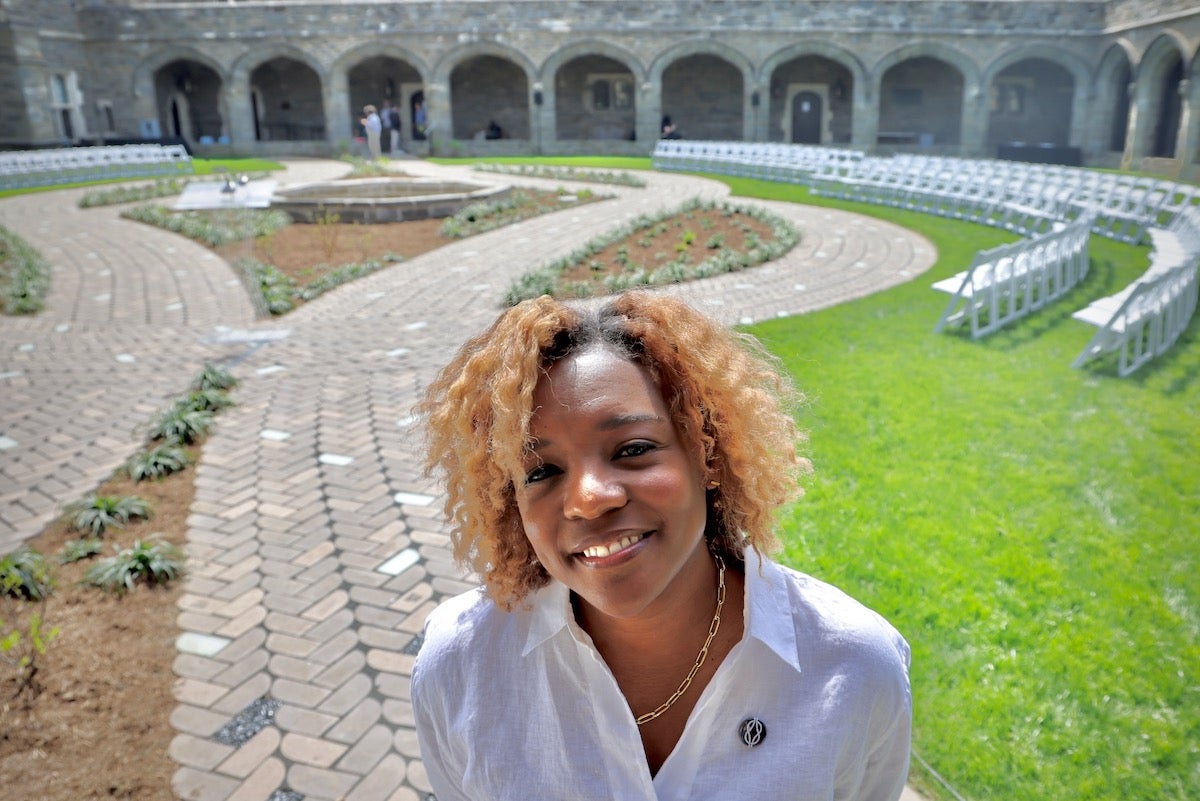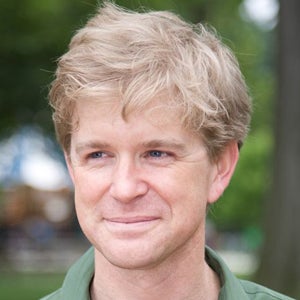Bryn Mawr College illuminates the forgotten names of its historic Black staff
“Don’t Forget to Remember (Me)” by Nekisha Durrett is a landscaping monument challenging the college’s racially exclusionary past.
Listen 1:20
''Don't Forget to Remember (Me)'' consists of braided pathways through the courtyard of the Cloisters at Bryn Mawr College. It acknowleges the work of Bryn Mawr's Black staff from 1900 to 1940 and the hardships of the college's first Black graduate, Enid Cook (1931). (Emma Lee/WHYY)
From Philly and the Pa. suburbs to South Jersey and Delaware, what would you like WHYY News to cover? Let us know!
When Washington, D.C.-based artist Nekisha Durrett visited Bryn Mawr College in 2023 to conceive a new monument to the school’s Black history, she thought about Enid Cook.
Cook was Bryn Mawr’s first Black student, entering the school in 1927 to study biology. But her admission was highly contested. The school’s president at the time, Marion Park, strongly urged Cook to reconsider applying to “a region of much prejudice and in a college where the prejudice is shared by many students.”
The school’s former president, M. Cary Thomas, who was then an influential board member who believed white students had superior intellect, also opposed Cook’s admission. During Thomas’ formative tenure as president from 1894 to 1922, she admitted no Jewish or Black students.
Cook overcame that racist opposition and enrolled, but was not allowed to live on campus. She found lodging about a mile away, a distance she walked every day to get to class. By the time Cook graduated in 1931, the only other Black faces she would have seen on campus were the people hired to maintain it.
“I, too, have been in a predominantly white academic environment,” said Durrett, who went to Cooper Union in New York City in the 1990s. “I can remember being only one of three Black people who were admitted my year.”
“I would always look for faces that felt safe, faces that look like me,” she said. “They were security. They were custodial staff. But these are people whose names I knew. I knew things about their lives. They knew things about my life.”
This weekend, Bryn Mawr unveils Durrett’s “Don’t Forget to Remember (Me),” a winding pathway through the landscaped quad inside the Cloisters of Bryn Mawr’s Old Library. The brick pathway echoes the walk that Cook was forced to take daily, marked with the names of Black staff she might have known.

Each rectangular brick was crafted with a rounded corner. When laid out, they form what looks like braids, a nod to the Black hairstyle worn by Durrett’s campus guide in 2023, Fatmata Sesay.
“Those braids kept sticking out to me as a symbol, thinking about braids as a protective hairstyle,” Durrett said. “Those strands of hair are so much stronger together than they are apart.”
Illuminating a forgotten past
Nearly 250 of those bricks are etched with the names of Bryn Mawr’s Black staff hired between 1900 and 1930, who worked as maids, servers, laundresses and other roles. People like Henry Rowland, Ella Blackwell, Cornelius Finch, Mamie Bailey and Jacob “Jake” Roselle.
Durrett lifted the names from archival time cards those laborers used to punch in and out of work.
“In 1960, they were rescued from a fire,” Durett said of the timecards. “They’re beautiful. They have charred markings along the edge. They’re tattered and really fragile, like if you were to handle them the wrong way they could disintegrate.”

Durrett assumes there were more names of Black staff that were not preserved in the historic record. About 300 of the bricks in the footpath are made of glass and wired for illumination. At night the path is speckled with the light of those forgotten people from a century ago.
“Even though Black students weren’t admitted to the college, there was a Black presence at the college,” said Monique Scott, an associate professor of art history at Bryn Mawr and co-director of Art Remediating Campus Histories, which commissioned “Don’t Forget.”
“We have always been here,” she said. “Black people have always been part of the foundational fabric of this college.”

“Don’t Forget” stands on the shoulders of work Bryn Mawr students have been doing for over a decade to research the history of Black students and staff at the college. The Black at Bryn Mawr program has illuminated the college’s racial exclusionary practices in its early years and the sometimes tentative steps made to overcome them.
When Park agreed to admit Cook, Thomas wrote a letter in 1926 saying the college is best suited for white women from Mid-Atlantic states, and efforts toward racial integration were ill-advised.
“I believe that the result of the scientific studies of the effects of immigration and of the teachings of heredity now being made are leading us in the other direction,” Thomas said.
In 2018, the work of Black at Bryn Mawr, along with others on campus, led to the scrubbing of Thomas’ name off of what had been Thomas Library and Thomas Hall, now called Old Library and Great Hall.
A heavy gloom
Even with Thomas’ name removed from the building, many students found Old Library’s landscaped quad creepy, according to Durrett. Upon Thomas’ death in 1935, her ashes were scattered there.
“I felt that same feeling, not even knowing all of the history of the space,” Durrett said. “When I walked in, I felt a gloom, a heaviness.”
“Don’t Forget” was conceived in consultation with the Monument Lab, a Philadelphia-based organization that’s rethinking what a contemporary public monument can be. The lab created a public engagement process that draws constituents into thinking about what they want a monument to represent, and where it should be put.
“People here on campus — students, staff, alums, faculty — would mark the official and unofficial places of history on this campus,” said Monument Lab co-founder Paul Farber. “Though many places were indicated, the Cloisters kept being a point of return.”
In addition to the historic and cultural work “Don’t Forget” is doing, it also accomplished a practical element that makes an immediate impact on everybody who enters. The ground was raised about a foot, so what had been a depressed area pedestrians had to step down into is now flush at the same level as the Cloisters.
“Here were visible and invisible barriers repelling people from the space,” Farber said. “That there are fewer barriers even to traverse the space — whether you are walking, in a wheelchair, whether you have a stroller — it practices what it preaches: that there is a space for everyone to be welcome.”

Get daily updates from WHYY News!
WHYY is your source for fact-based, in-depth journalism and information. As a nonprofit organization, we rely on financial support from readers like you. Please give today.






